Meal prepping offers affordable, simple, and healthy solutions to making meals for an individual or family in a way that saves time.
Jumping in on the meal prep bandwagon can be wise for a future business owner, as it’s an industry that doesn’t seem to be slowing down any time soon.
This guide can help you make the most of the potential that a meal prep business has so that you also can find success in the niche.
Top Business Formation Services to Start a Meal Prep Business
If you want to start a meal prep business, you should create a legal business entity first. This takes very little time, money, and effort, but it will save you a lot of headaches down the road if your business takes off.
Protect your personal assets and stay in the clear with state regulators. Use a business formation service to establish an LLC or corporation in minutes.
- ZenBusiness – Best overall value
- Incfile – Best low-cost formation services
- Northwest Registered Agent – Best registered agent services
- Rocket Lawyer – Best for ongoing legal advice
- LegalNature – Best for managing business formation documents
- Inc Authority – Best free LLC setup
- LegalZoom – Best range of business formation services
- Incorporate – Best for C-Corps and S-Corps
- Swyft Filings – Best customer support
- MyCompanyWorks – Best for fast setups
- MyCorporation – Best for free EIN
You can read our full reviews of each business formation service here.
5 Steps to Start a Meal Prep Business
If you’re ready to start a meal prep business, just follow these simple instructions below:
- Set up your business
- Prepare for business
- Nail down the details
- Find your ideal clients
- Grow your meal prep business
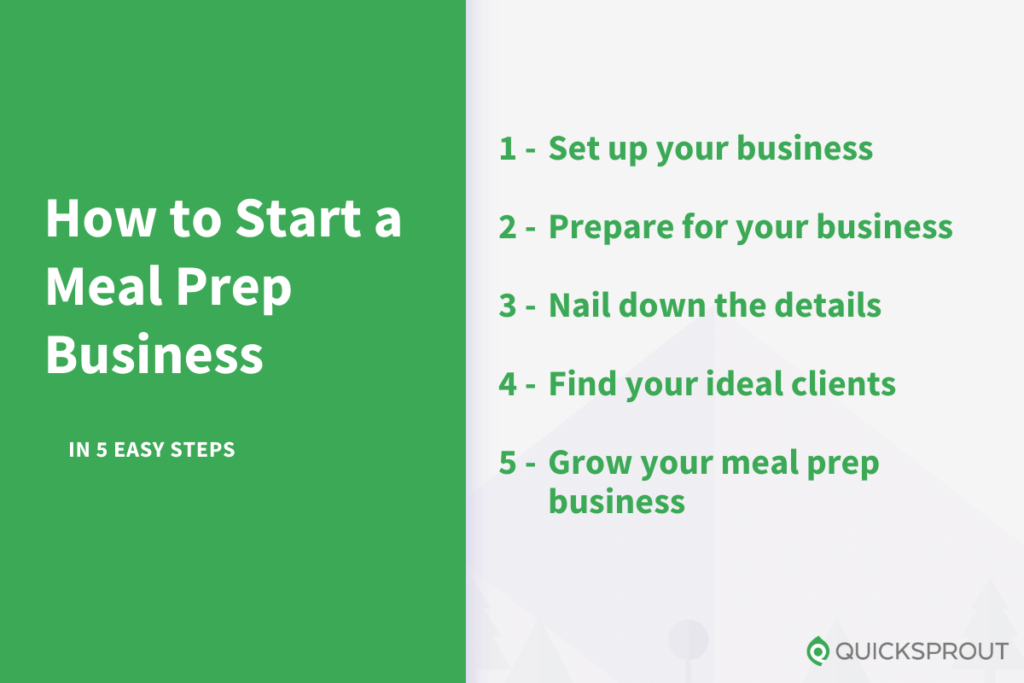
The Easy Parts of Starting a Meal Prep Business
Meal prepping is so popular that these businesses often sell themselves. You won’t have to spend much time convincing potential customers that meal prepping is good for them by saving time and money and putting healthy food on the table.
And if you love cooking and know how to put healthy ingredients together, you don’t have to have any special licenses or degrees to get started. In this industry, people tend to value the final product more than the credentials you have.
A meal prep business that starts small, as many do, doesn’t require a significant investment to get started, either. It’s plausible for you to start your business from your home kitchen with an investment of under $5,000 until you feel ready to scale.
You can also take a lot of work off your shoulders by investing in meal prep software, like Meallogix. The software gives you a custom digital storefront, a list of ingredients to shop for based on your orders, an inventory manager, and nutrition labels to transform your business into a legitimate company.
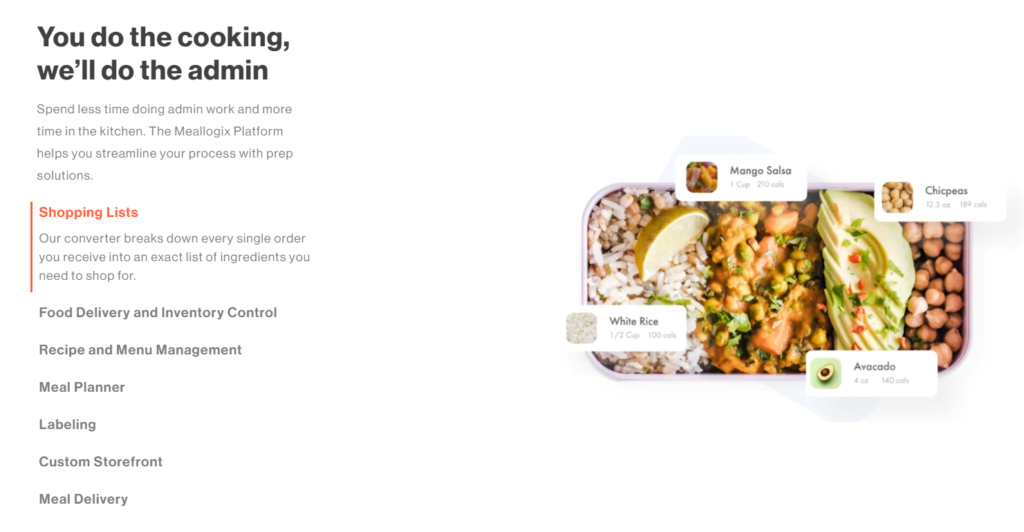
The Difficult Parts of Starting a Meal Prep Business
Believe it or not, the most challenging part of a meal prep business will probably be learning how to stand out from the thousands of similar companies in the industry. Meal prep has picked up so much steam in the last few years that it can be difficult for you to distinguish your business as different from others. You should consider spending plenty of time nailing down a unique niche before formalizing your business.
Scaling a meal prep business can also be difficult. Using fresh ingredients can limit how far you deliver your meals, which restricts the customer base you sell to. To grow outwards, you’ll need to invest in better shipping options and potentially more manufacturing facilities to get your fresh foods to those who want them. It certainly requires a hefty investment to make these changes.
Keeping up with customer service can also be a full-time job in itself. Meal prep companies need to be available around the clock to answer questions about ingredients and solve problems relating to deliveries and spoilage. It pays to have a dedicated person or team to help, but that’s another cost you’ll need to figure in.
Finally, meal prep business owners working out of their own kitchens might find it tough to separate work from their personal life. With all the work you put into your business, you might even lose a bit of the passion that convinced you to start your business in the first place. Working at a facility rather than the home might help, but it may not solve the problem.
Step 1: Set Up Your Business
Before serving customers delicious meals you’ve prepped yourself, you’ll need to take time to set up your business correctly. A strong foundation ensures that your business is legally ready to go and has a clear business model that customers will cling to.
Decide On a Niche
The most important part of the planning stages is coming up with a business model for your meal prep business. Since these businesses are common today, it’s necessary to find a way for your business to stand out with a unique niche.
Start by deciding what you can offer your clients. Will your meal prep business target a specific group, like kid-friendly meals? Do you focus on plant-based meals? Or, maybe you want to help people with specific dietary needs, like low-carb eating.
Once you have a niche, you can carve out your space in the meal prep world. Your business name, marketing strategy, and business model can all fall into place.
Legally Form Your Business Entity
Now, decide on which business entity you’ll have:
- Sole proprietorship: Sole proprietorships have just one owner and are considered a pass-through entity, meaning that all your business income passes through to you. You’ll report your business taxes with your personal tax return using IRS tax form Schedule C. This is a simple business structure to set up, as it legally forms once you start conducting business.
- Partnership: A partnership is a business with two or more people sharing ownership. Each party is responsible for funding the business and sharing its profits and losses.
- Limited liability company (LLC): LLCs require more paperwork than a sole proprietorship to start, but a single owner may form one. It’s also a pass-through entity that can simplify tax filing, and it protects the owner’s personal assets from legal situations involving the business.
- Corporation: Corporations exist completely separately from owners and shareholders. They’re more expensive and complicated to start and have several requirements to remain in business, like conducting shareholder meetings. C corporations are not pass-through entities, while S corporations are for tax purposes.
You can file your business papers through your state’s Secretary of State website or use a business formation service to help. Inc Authority is an excellent option for LLC owners, as it offers free LLC formation and a tax planning consultation.
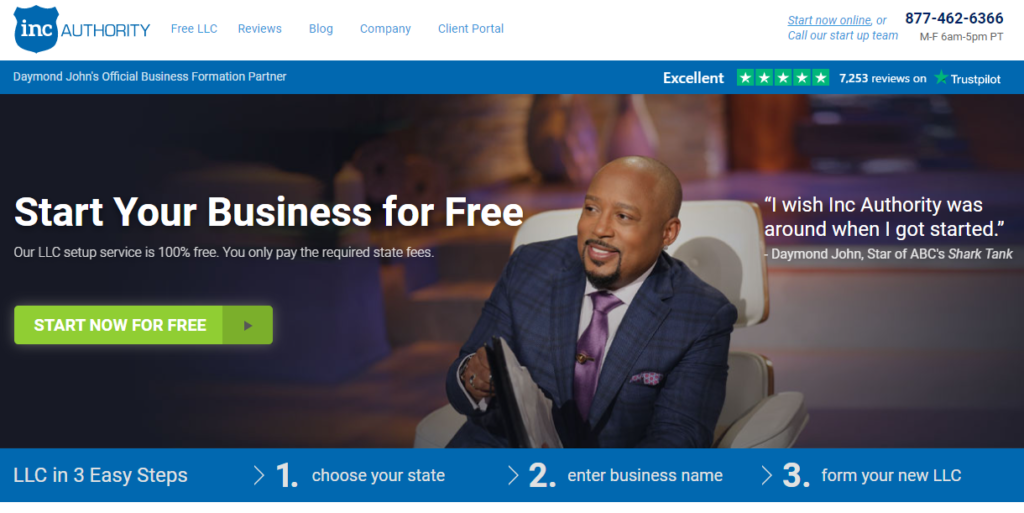
For other formations, try Incfile, an affordable service with free registered agent services for one year.
Get Insurance
Because you’ll be serving food to customers, you’ll want to protect your business with insurance. Not only can the right insurance protect the equipment and space you use to cook meals, but it can also safeguard your business if a customer gets sick from your food.
Business insurance providers offer different types of insurance for various business models. However, general liability is a must for a meal prep business. General liability insurance can protect your business from lawsuits, attorney fees, and medical expenses that your business may be responsible for.
If you’re cooking from your home, you may also need additional homeowner’s insurance coverage to protect your home and kitchen equipment. Separate facilities should have property insurance to protect against natural disasters or environmental hazards that could damage your business property.
Separate Your Finances
Even if you have a pass-through business entity, you should consider separating your personal from business finances. The easiest way to do that is to set yourself up with a business banking account. Come tax time, having all your business income and expenses together in one account will make filing incredibly easier.
Plus, having a separate account can make it easier to establish that your business is a legitimate, legal business.
Online banking offers additional conveniences for business owners, like having 24/7 access to your money and mobile depositing capabilities. Novo is one of my favorites for small business owners needing a business checking account, but LendingClub is a great option for growing businesses. If you prefer having both online and in-person business banking, open a Chase Business Complete Banking account.
Step 2: Prepare for Business
With your business legally formed and ready to roll, it’s now time to get more details ironed out that will help you run and market your business.
Set Up Business Software
Let me start by saying that if you can find software that will help you run your business, get it. Plain and simple.
For a meal prep business, Meallogix is the answer. This software takes backend business tasks off your plate, like figuring out which ingredients you need to order and calculating nutrition information for the meals you make. And it keeps everything organized in an easy-to-use dashboard that has every metric, payment, and report at your fingertips.

Meallogix is 100% designed for meal prep companies. The software creates shopping lists based on what customers have ordered to avoid waste or missing ingredients. You’ll also get a meal planning calendar to plan out a few weeks or months ahead of time. Additionally, Meallogix includes:
- Payment processing
- Recipe cost analysis and reporting
- Customer management
- Meal plan subscriptions
- Inventory control
- A custom online storefront
Meallogix starts at $149 a month, and you can request a demo before you sign up to test it out and make sure it’s the right choice.
Get a Website
If you’re going with Meallogix, you can get your custom storefront with your subscription. This will be the cheapest way to go since it offers several features you’d find on other ecommerce builders plus its payment processing, reporting, and other perks. However, if Meallogix isn’t in the budget right now, you can start your website elsewhere for less money.
Either way, a website is a must. People can visit to learn more about your meals and ingredients, pricing, and what makes your business different. It can also act as your customer service hub, allowing customers to contact you with questions and concerns.
If you have no website-building experience, it’s best to start with a website builder designed for ecommerce. For most people, I recommend Wix. It includes more than 500 templates, payment processing support, a drag-and-drop builder, and several ways to give customers discounts to keep them coming back.
Wix also offers world-class security. It has a team of security experts working 24/7 to constantly monitor for and prevent cybersecurity threats, and uses high-level data encryption to protect your site. Wix also boasts a 99.98 percent uptime.

Wix starts at $23/month for its ecommerce plans. However, if you want to offer subscription plans for your meal prep customers, you should opt for at least the Business Unlimited plan for $27/month.
Step 3: Nail Down the Details
As you get closer to preparing delicious meals for customers, there are several more details to figure out for your meal prep business.
Form a Budget
First, there’s the budget you have to work with as you start serving customers. A meal prep business can be costly at first because you might not have the resources available to get the most affordable pricing for packaging and shipping costs. It’s necessary—at this stage, especially—to work within a strict budget that ensures you’re making a profit on your time and money spent.
At least for the first few months of business, jot down every single expense, from each ingredient to each meal package you pay for. Figure in shipping costs, the time it takes you to make each meal, and business costs, like your monthly meal prep software subscription. Are the prices you charge covering all these costs and giving you a profit?
It’s in your best interest to hire an accountant to help you stick to a budget and determine whether your pricing and expenses match up. If you don’t yet have the means to afford one, consider using QuickBooks to track this information yourself until you can scale up.
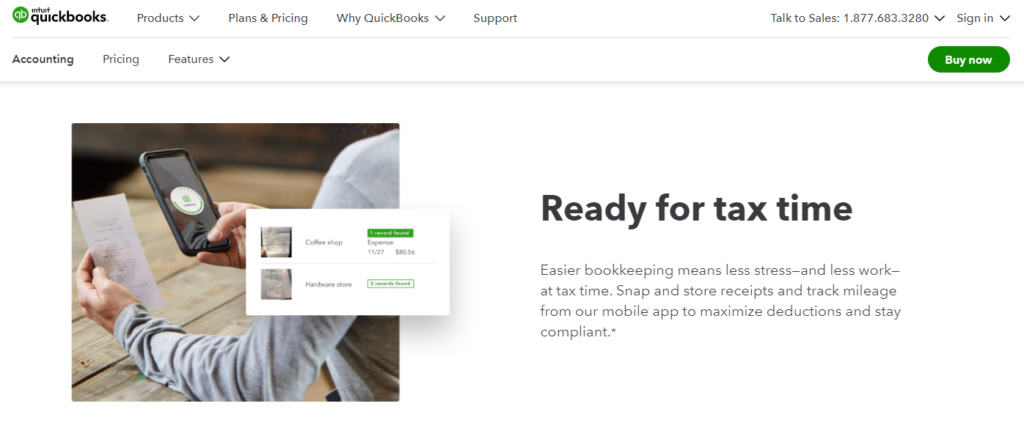
Source Ingredients
Buying ingredients in bulk can usually save you money over buying smaller amounts. However, you also have to be mindful of your business model. If you say you only use plant-based ingredients, you need to make sure you’re sticking to that.
Your best bet is to research food distributors in your area. They typically offer bulk foods for prices lower than what you’d find in supermarkets. Plus, you can contract with them to supply continuous ingredients you frequently use in your meals.
For produce, turn to local farms and farmer’s markets. You can have the additional benefit of marketing your meals as ones that include ingredients from local farmers.
Most importantly, compare pricing. As you inch deeper into your business, you’ll learn where you can cut costs for effective pricing. But price comparisons are at the heart of that. Get price lists from different distributors and manufacturers to determine which ingredients to order from each place.
Decide Where Your Customer Base Will Be
Logistics can interfere with an excellent meal prep business model. Shipping to people out-of-state adds a whole new layer of complication to ensuring freshness and keeping costs down. As a new business, it might be best to cater only to local customers that you can deliver or ship to easily.
Of course, this limits your reach. If you’re sure about wanting to set your sights on selling to people outside of your immediate area, talk to shipping companies to determine the rules for doing so. Some states have specific regulations for shipping fresh food that could make deliveries to those areas unprofitable.
Step 4: Find Your Ideal Clients
Your business is off to a great start. Now, it’s time to grow it through marketing to the people who will be interested in it.
Advertising
Meal prep businesses cater to specific demographics. People who love healthy meals but also love to save time are perfect customers. However, they still want to know what your business will do differently than the hundreds to thousands of other meal prep companies in the industry.
That’s where your advertising comes in. Your website will be an essential part of your marketing because it is where people will go to learn more about you. But you’ll need to draw customers there first.
Paid search ads on Google can be an excellent way to grab people who are already searching for a business like yours. To start a new campaign, create or log into your Google Ads account. Then, click on the + sign to create a campaign.
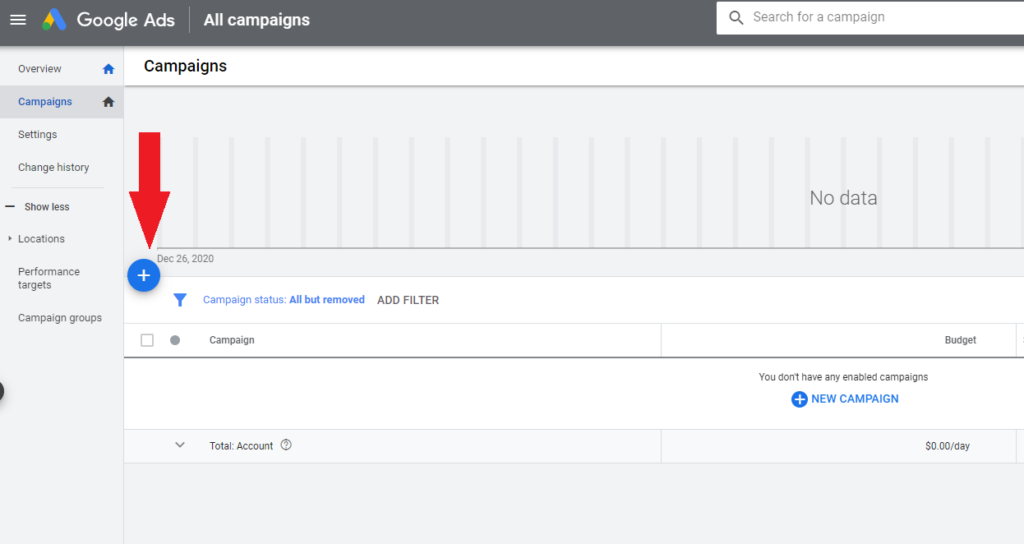
Next, choose a goal for your campaign. When starting out, you’re trying to get new customers over to your business, so Brand awareness and reach would likely be the best goal for you.
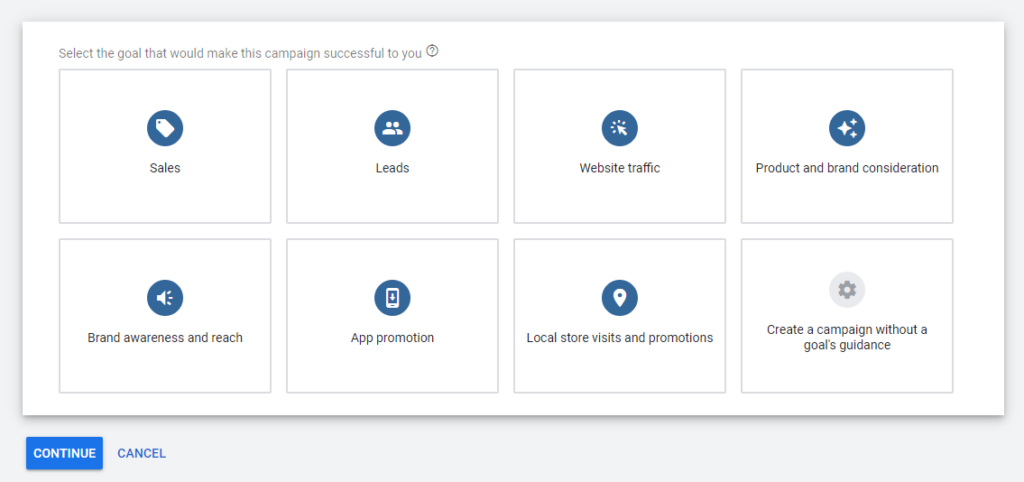
From here, Google Ads walks you through the process of setting up your campaign. Choose your daily budget, geotargeting, keywords, and other metrics. When finished, review what your ad will look like and start getting customers.
Leveraging Social Media
Social media is a must for meal prep business owners, simply because people looking for quick, convenient meals are often hanging out online and researching tips. Instagram is a popular place for these businesses to advertise because enticing photos of their meals can go a long way.
Not only can you use all the free features of social media platforms to show off what you sell to your customers, but you can also try paid ads on them. Consider starting out with Google Ads first and making your way into Instagram and Facebook advertising once your budget expands.
Step 5: Grow Your Meal Prep Business
You can only work so long for yourself making meals from your kitchen for your business. Soon, it’ll be time to scale.
Expand Your Staff
Hiring employees is a must as you grow your business. Whether it’s finding someone to take over social media and customer support or adding a few new cooks to the kitchen, your staff can get things moving quickly for customers and take tasks off your hands.
Recruiting software can streamline your hiring process by posting jobs to job boards all over the web and managing your applications.
Once you do get more staff to help, Meallogix can work behind the scenes to make sure everyone stays on the same page. The software’s kitchen backend stores your recipes and manages ingredients, giving everyone all the necessary information to make meals to your standards.
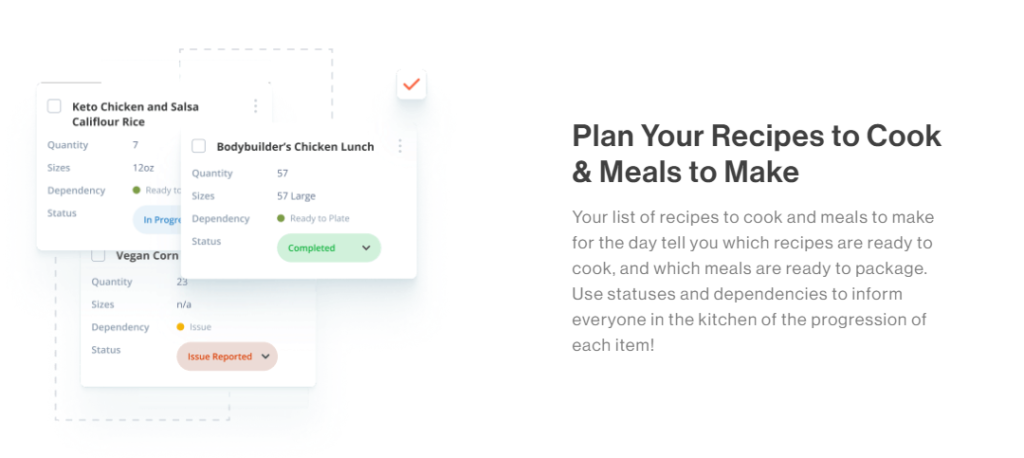
Revise Your Business Model
As your business grows, you might need to adjust your business model. Hyperlocal businesses might expand to interstate meal delivery services, requiring more helping hands and more efficient cooking, order processing, and shipping.
Consider reevaluating your business model quarterly, especially in the early stages of growth. Doing so can let you know if your company is prepared to handle your customers and their needs as well as you’ve planned for.
Bringing in a business consultant could be a good idea at this point to ease the growing pains you might feel from quick expansion.
from Quick Sprout https://ift.tt/U6entBR
via IFTTT
